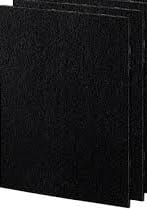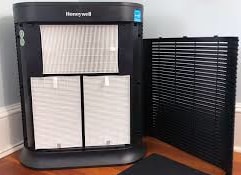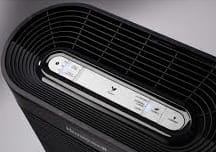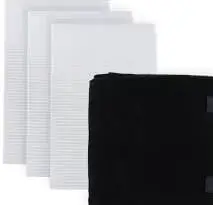Last Updated on January 25, 2021 by Peter Simmons
Editor’s rating:  (4 / 5)
(4 / 5)
This Honeywell HPA300 review reveals what doctors and other medical experts have known for years now. These scientists have long agreed that using an air purifier, especially one that uses a true HEPA filter, may help allergies and asthma. But is the Honeywell HPA300 the best air purifier for your specific needs? We’ll see.
Honeywell makes some of the best air purifiers on the planet. That’s a fact. If that were not so, the HPA300 True HEPA Allergen Remover 465 sq. Ft and others would have attracted tons of negative reviews online. But the vast majority of reviews I’ve seen are positive.
*Affiliate Links Disclosure
This website participates in the Amazon Associates program. And as an Amazon Associate, I earn from qualifying purchases. However, you won’t pay a dime more for clicking on any of the affiliate links in this content.
Contents
Why I Wrote this Honeywell HPA300 Review
It’s not like writing reviews feels particularly exciting. So why did I spend my precious time piecing together this 5,000+ word review?
I intend to provide you with enough information so you can preview the deal you’re about to shell out money for. I hope to give you sufficient critical information so you can make an informed buying decision.
That’s why I’ve included comparisons between this Honeywell and a couple similar models. I’ve also stood the HPA300 beside 2 of its siblings, the Honeywell HPA200 and HPA100, so you can see how it stacks up. Read on and decide whether you want to own this Honeywell air purifier, one of its siblings, or anything else you may like.
Conquer Your Allergy Symptoms


Honeywell True HEPA Allergen Remover, 465 sq. Ft, HPA300
The device stands tall among the most popular, efficient, and highly rated air purifiers on the market. Honeywell air cleaning devices, and the HPA300 in particular, is about as popular as some of the most popular GermGuardian purifiers.
Doctors love Honeywell air purifiers. They keep recommending them to their patients. And it’s not because these devices are cute or something like that. It’s because they’re exceptional allergen removers. The thing may be overkill for a small bedroom, though.

It’s best suited for large bedrooms and living rooms. It’s also the solution you need to address the mold issue down in the basement. With this, mold spores will stop floating into every other area of your home, polluting the air and worsening your symptoms.
If it’s too large for your bedroom (it most likely is), you can always buy it’s smaller sibling, the Honeywell HPA100 True HEPA Allergen Remover (Renewed) (155 square feet).
It’s a Large-room Air Cleaner
I’ll kick off this review with one bold but true statement. It’s that the HPA300 air purifier is an excellent air cleaner for purifying large and extra-large rooms. The device sanitizes all the air in rooms as spacious as 465 sq. ft., circulating the air 5 times in 1 hour (ACH).
If your room is about 21 x 22 feet, the HPA300 is your best bet. But you can also use it for smaller rooms. However, it’d be overkill if you used it to clean a very small room, say 11 ft. x 10 ft. (the standard small bedroom size in the U.S.). In such a case, it’d be much better to buy a smaller device and save money on electricity.
The HPA300 Uses True HEPA filters
The HPA300 uses 3 rather thick True HEPA filters that filter out at least 99.97% of 0.3-micron particulates. The (black) charcoal filters you see strive to reduce VOCs, smoke, and odors.
The unit uses certified True HEPA filters to remove at least 99.97 percent of allergens bigger than 0.3 microns. It’s the perfect pick for when you need to banish pet dander, household dust, pollen, and mold spore issues.
In addition, the purifier helps you eliminate different kinds of odors, thanks to its activated carbon odors removal filter. That’s what Honeywell says. But I’ve seen enough anecdotal evidence (including reviews on Amazon) to conclude there’s lots of truth in this claim. Aside from that, the device can remove bacteria and even viruses from your indoor air.
But does the unit remove particles smaller than 0.3 microns? Yes, it does. When the manufacturer says “99.97% of particles with a diameter of 0.3 microns, it doesn’t mean those are the only particles eliminated. Usually, 0.3-micron particles are used as a standard because they’re very difficult to remove.
In truth, True HEPA air purifiers also remove smaller particles, including those as small as 0.01 particles. I suggest that you read this article: Do HEPA air purifiers remove PM2.5? You’ll gain a much better understanding of how portent HEPA purifiers really are.
Does It Eliminate Smoke?
The simple answer is that it does. But I’ll quickly add that it does so to a limited extent. And in the end, the device may not eliminate the deadly carcinogens found abundantly in tobacco smoke.
Most people who write or talk about about air purifiers keep succumbing to one temptation. They repeatedly say that true HEPA filters remove EVERY trace of cigarette smoke. I agree that these filters are effective. However, I must say that some people are economical with the truth in this regard. The best way to avoid the effects of carcinogens is to quit smoking.
The second best way is to minimize exposures to secondhand smoke. If you or your spouse smoke, just don’t do it in the house. Tobacco smoke can harm children in many serious ways. You can read this article I wrote on secondhand and thirdhand smoke.
Many owners of this purifier say that it helps them deal with tobacco and wildfire smoke. But I’m not sure you should be smoking in the house, though.
What about wildfire smoke? Let’s hear what the U.S. EPA says about it.
What the EPA Says about Wildfire Smoke
The issue as to whether True HEPA air purifiers remove smoke is a longstanding one. According to the U.S. Environmental Protection Agency, smoke particles emanating from wildfire range between 0.3 to 0.4 microns in size.
Remember: True HEPA filters remove up to 99.97% of 0.3-micron pollution. It’d be easy to conclude that such air purifiers effectively remove almost all traces of smoke.
But smoke contains a lot more than just particulate matter. Yes, the best air purifiers for smoke may reduce wildfire smoke, tobacco smoke, cooking odors, toxic fumes, and other pollution sources. But if wildfire smoke or any other kind of smoke contains too many smaller-than-0.3 particles, your HPA300 may not remove the majority of them. That said, there’s little doubt that this device helps with smoke and VOCs.
Does the HPA300 Help with Allergies?
It’s a great product that can help you effectively manage asthma and allergy symptoms. Running it 24/7 can dramatically improve the air quality in your home. People who use this purifier report being better able to manage their allergies and asthma.
One of those people happens to be my SO, Mary. My wife is allergic to pollen, dust bunnies, and many other allergens. Luckily, we have this air purifier in our 20 X 20 living room. We bought it after reading HPA300 reviews on Amazon and learning that it’s quite popular.
Well, I can’t say her allergies have vanished. They haven’t. But if I didn’t tell you that my wife’s allergies bother her much less, I’d be lying.
We also have another device in our medium size bedroom (the HPA200). Thanks to this unit, my wife’s sleep has improved dramatically. Without this solution, pollen would continue to ruthlessly bludgeon her peace-of-mind.
People who are allergic to pollen and asthma sufferers should seriously consider buying this air purifier. But owning the device will not eliminate dusting, cleaning, and vacuuming. That’s why we keep our home sparkling clean at all times. Still, you’ll have much less dust around to worry about with this machine.
But this Air Cleaner Isn’t Perfect
It’s extremely hard to find a perfect product in any industry. And this device is no exception. Users may notice a few small issues such as too much noise when on Turbo setting. Or even a chemical odor when newly installed.
In this review, I’ll provide a detailed, unbiased opinion about this product. Hopefully, you’ll find the review helpful.
First things first: Features. I’ll list all the pertinent features and then dive with you into each of them to see what’s in it for you.
Let’s roll.
Specs
- Model: HPA300
- Material: ABS plastic with a satin black finish
- Coverage: Up to 465 sq. ft.
- Product dimensions: 20″L x 10.8″ W x 22.3″ H
- Replaceable Filters: 3 True HEPA filters (type R)
- 1 replaceable prefilter HRF-AP1
- 4 cleaning levels including a Turbo
- Weight: 24 lbs
- Cord length: 6 ft.
- Unique separate reminders for filter replacement
- Automatic shut-off timer at 2, 4, or 8 hours
- Adjustable lighting for control panel
- Touch-sensitive controls
- ACH: 5 on Turbo setting
- CADR rating for smoke is 300
- CADR rating for dust is 320
- CADR rating for Pollen 300
- Warranty: 5 year limited warranty
- Energy Star certified
Before we discuss these benefits, let’s look at the pros and cons of owning this air purifier.
Pros
- A clean, simple, great looking design
- Super easy to install
- Easy to clean
- Improves allergy symptoms quickly
- Prefilter replaceable without having to replace the HEPA filters
- True HEPA filters
- Not obtrusive
- automatic shut off timer
- Versatile: effectively cleans large, extra-large, and medium-sized rooms
- Reminds user to replace filters and prefilter
- Clearly written user label
- Control panel’s brightness won’t bother you at night
- Portable
- Under $200
- Filter replacement reminder
- 3 HEPA filters offer very thorough filtration
Cons
- No remote control
- The true HEPA filters can be a bit pricey
- Currently available in black color only
- Turbo setting can be too loud
- Auto shut-off timer only works for 2,4, or 8 hours
- Names for various settings can be confusing for new users
- Some users have complained of noxious orders especially while replacing filters
- Sometimes, touch buttons may take a while before registering touch
- Energy consumption high
First Impressions
When you see the HPA300 for the first time, you get the impression that you’re looking at a high-quality product. The product’s build is easy on the eye, too. Simple, sturdy, and practical are the words that popped into my mind when I first saw it.
In addition, the product feels great to touch. Aside from that, you won’t find any rattling parts or loose ones. All the panels line up perfectly. In other words, the engineering seems excellent.
The device comes with a clearly written “new user” label. The label helps new owners to quickly familiarize themselves with the device. It explains how to remove and replace the front grill easily so you can insert or remove the filters.
The label also explains how to operate this air purifier’s “easy tap” controls. Simply tap the relevant icon on the panel and voilà! You can:
- Tap to turn the air purifier on or off
- Tap to select a desired fan speed
- Tap to choose the Turbo cleaning mode
- Tap to select the auto shut-off timer to 2, 4, or 8 hours
- Tap to turn lights on or off or to customize brightness
Note: It’s easy to think that the filters are ready to use. But don’t turn this Honeywell on, yet. First, remove the filters from the packaging. Then, install them. I’ll explain how to install the filters and prefilter later on in this review.
Make Use of the Quick Reference Guide
The unit comes with a “Quick Reference Guide.” To get it, simply pull the small tab at the top of the device near the controls. Once you do that, you’ll see a clearly written quick reference guide.
The guide contains helpful instructions including Honeywell’s customer support phone number. You could still operate this device without reading the quick reference guide, though. Still, it’s a nice addition that I’ve not seen in quite a few similar air purifiers.
How the Honeywell HPA300 Works
The unit performs double filtration efficiently. The first stage happens at the unit’s highly effective prefilter. The second phase of air filtration happens as dirty air passes through the unit’s 3 True HEPA filters.
The unit needs one prefilter and three True HEPA filters to function efficiently. I’ll now describe the air filtration process.
Air Filtration at the Pre-filter
Air gets drawn into the unit through a grill at the front side of the HPA300. Then, it passes on to the prefilter. Here, large particles such as pet hair, lint, human hair, skin flakes get removed.
I saw the evidence of this air purifier’s potency when replacing the prefilter. The prefilter was grimy. It was a complete mess. But I was glad that all the filth was right there on the filter and not in my blood!
From the prefilter stage, the air proceeds to the device’s 3 True HEPA filters.
But before I discuss the second stage of the cleaning process, let me tell you more about the prefilters.
The HPA300 Uses Activated Carbon Prefilters

A good portion of the prefilter is basically activated charcoal. The prefilter covers entirely the front area of the HPA300. Of course, it remains hidden behind the front grill.
Now, there are tons of BIG claims made about activated charcoal.
Here are some of those claims:
- Activated charcoal whitens teeth
- Activated charcoal improves heart health
- Activated charcoal lowers bad cholesterol
- Activated charcoal treats skin problems
- Activated charcoal has anti-aging properties
- Activated charcoal potentially cures hangovers
Now, those are bold claims. But there’a an important truth you should know. There just isn’t enough conclusive evidence that these claims are 100% true.
So, insert the word “potentially” after the word “charcoal.” And you’ll begin seeing the claims for what they truly are. I won’t say the claims amount to nothing more than speculation. But most of the evidence is pretty much anecdotal. That means these filters have no proven ability to help allergy sufferers, right? Wrong.
As you’ll see below, activated carbon is great at eradicating bothersome smells. It’s critical for someone with smoke problems to keep this point in mind when shopping.
The prefilter for the HPA300 works. Do you have pets, especially cats? Human hair and fur from pets can clog up your unit’s prefilter real quick. While changing the prefilter, you won’t people believe all of that filthy stuff actually came from your home. This prefilter is designed to take care of relatively large particles. But it should also help you suppress household odors.
Evidence Shows Activated Carbon Eliminates Certain Contaminants
According to NCBI, medical practitioners usually use activated charcoal to eliminate contaminants from the digestive tract. It’s therefore not surprising that the HPA300 uses a prefilter made of activated charcoal.
Aside from reducing odors, the prefilter prolongs the life of your true HEPA filters. If the prefilter is working properly, your true HEPA filters end up with less work to do. Since they have less work to do, they’ll last longer, and you’ll replace them less frequently. And that means savings.
True HEPA Filtration
What happens at the true HEPA filters?
The unit’s 3 true HEPA filters receive partially cleaned air from the prefilter. The term HEPA stands for high-efficiency particulate air.
True HEPA air filters should remove at least 99.97 percent of particles with a diameter of 0.3 microns or larger. That’s a requirement by the U.S. Department of Energy. True HEPA filters do the heavy lifting when it comes to removing super fine particles from your indoor air. Whatever the prefilter couldn’t pick gets taken out by these filters.
These true HEPA filters feature many pleats. The pleats give them a large surface area so they can trap particles effectively. When it comes to change these filters (for the first time), you’ll be shocked. You’ll wonder, “How have I survived all these years without using an air purifier? And you’ll want to call, text, or email your friends about your discovery.
How Does the Air Enter and Exit the HPA300?
Dirty air enters the unit via the front grill. After filtration through the two stages detailed above, fresh clean air leaves the unit via the top. It exits via an air grate located near the controls at the top of the device.
Now, that’s a really good thing. In most homes, air purifiers stand in the middle of the room because they require lots of space to operate efficiently.
But that’s not the case with this option. Due to its design, you can position this air purifier against a wall, and you won’t see reduced performance. You’ll worry less about space limitations.
No Obstructions with the HPA300
Most air purifiers suck in air from the back, purify it, and spew it out the front. That means you must place them some distance away from the wall.
In contrast, it’s easy to “hide” the Honeywell and still enjoy all of the awesome benefits it delivers. Simply plug the HPA300 into some corner, set it and forget it. Utilize the rest of the space for other purposes.
How to Install the filters for the HPA300
It takes no more than a couple minutes. Simply remove the front grill. Then, click the the new True HEPA filters into place. And that should be pretty easy. Next, place the prefilter in front of the True HEPA filters, and you’re done!

Freshly installed HEPA filters

Precut Filter Alternative
Not everyone uses a precut replacement prefilter. Honeywell HPA300 owners who like saving money may prefer to buy a sheet of activated carbon. They then cut it up into several prefilters and that’s about it.
However, that necessitates a bit of precise measuring and cutting. And you can make mistakes. While this approach saves you money, there are reasons you might go the precut prefilter route.
The Best Precut Prefilter for this Purifier
The Premium VEVA precut prefilter works perfectly for Honeywell HPA300. You should be able to fit it in minutes. The VEVA Premium precut prefilter is available as a package containing four prefilters or more. A 4-pack filter should last you a whole year or even longer. The prefilter is affordable, don’t worry.
How Long Do Honeywell Filters Last? Are They Expensive?
Typically, the prefilter is replaced every 3 months, which means 4 times each year. As to the True HEPA filters, the recommendation is one filter replacement every 12 months. However, if your place is chock-full of pollutants, you’ll replace the filters more frequently. Usually, you won’t replace the prefilter and true HEPA filters at the same time.
They’re not the lowest-priced filter deals I’ve seen. But they’re affordable.
As of this writing, you can buy a 4-pack filter (prefilters) plus 1 set of HEPA filters for around $50. These supplies should be sufficient for a whole year. Does $50 sound like too much? No. Some comparable filters cost north of $150, and you may have to do 2 replacements. Think about $50 vs $300. It’s such a huge savings difference.
Note: prices keep changing. It’s best to visit Amazon and check the prefilter’s current price.
Control Panel and its Features

Let’s jump right in. Note that the features aren’t presented in any particular order.
Fan Speeds
The product features 4 fan speeds, including Turbo. It doesn’t come with the usual settings of low, medium, and high. Instead, you’ll see “Germ,” “General Clean,” “Allergen,” and “Turbo.” Let’s examine each of these filtration speeds in a little bit more detail.
Fan Speed 1: Germ
Anyone who owns this unit can tell you that its lowest setting is super quiet. But I’ve interacted with few unhappy owners who felt that this setting is somewhat louder than a similar setting on some comparable devices.
My opinion is that it’s as quiet as any other true HEPA air purifier out there designed for the same square footage. Generally, air purifiers that use true HEPA filters tend to be a little louder than those that use other technologies.
I find the Germ setting on my HPA300 surprisingly quiet for such a powerful machine. The Germ setting is the fan speed to choose while listening to some soul-lifting music. Or, while watching a movie. You may also choose the mode for sleep time.
Fan Speed 2: General Clean
On this setting, you’ll get a lot more filtration than you would on the Germ mode. However, you’ll get a little more noise. But the noise produced is far from what you’d call disturbing. In fact, the noise is almost inaudible. It doesn’t prevent you from connecting with your favorite band or author. At this noise level, my wife who’s a light sleeper enjoys her sleep without a problem.
Fan Speed 3: Allergen
Some people may not like being in the same room with this unit while it’s on this setting. Falling asleep might be a little tough, too.
But aren’t you mostly away from home for hours at a time? Your purifier should be in there working hard, helping you eliminate allergens.
The Allergen speed is the “everyday” speed for this device. At nighttime, though, you’ll probably want to switch to a lower fan speed. The allergen mode is also the setting to choose throughout flu season.
Fan Speed 4: Turbo
The Turbo mode is the highest setting on this device. On this setting, the unit runs furiously fast. You may not find the noise level particularly pleasing. But the power you get on Turbo is incredible.
ACH
It offers an ACH (air changes per hour) of 5. That means an occupant of a room with a square footage of 465 would see 5 air exchanges every 60 minutes. Note that you can only get such efficiency on the Turbo setting. At that setting, the unit purifies and circulates the air once every 12 minutes.
Now, it’s not a good idea to leave the thing on Turbo for too long. That’s because it’s quite loud, plus it consumes significantly more energy than the other settings.
So, when should I use the highest setting? If you contend daily with allergies or asthma, first run your purifier for some time (maybe 1-2 hours) on Turbo. Then, select a lower speed. That removes allergens super quickly. And the lower fan speed should help maintain that level of cleanliness.
It remains unclear to me why Honeywell uses these fan speed terms instead of simply Low, Medium, and High. But does using different names for settings make the device harder to operate? No.
Tap Your Way to Convenience
The unit comes with a sensitive, “easy tap” control panel. Whether you want to power off the device or switch to a different fan speed, just tap it. For the most part, the touch-sensitive “buttons” work without any issues.
But I must let you know one small fact. Sometimes the touch buttons don’t seem to respond as fast as I’d like. And I’ve read a couple of reviews on Amazon and elsewhere where users have made the same observation.
But I can’t say it’s something find particularly annoying. I can’ t say the issue has ever prevented me from using my HPA300. And in most cases, the issue of “taps” or “touches” not registering stems from not applying enough force.
Adjustable Lighting for Peaceful Sleep
Some people won’t sleep if there’s too much light in the room. Others can tolerate a certain level of lighting. The nice thing about this air purifier is that it lets you dim the light from the control panel as you like. You can dim the light or make it brighter. You can also turn it off completely if it bothers you.
Filter-change Indicator
In a world where everyone is crazy busy, it’s easy to forget things. Even important ones like filter replacement. But the HPA300 is intelligent enough to know when it’s time to change the filters. There are two lights: one for the prefilter and the other for the HEPA filters.
I like that you can change the filters separately. In many air purifiers I’ve reviewed, the HEPA and odor filter are parts of the same component. And in most cases, you can’t change one without the other.
By contrast, you can replace either the prefilter or HEPA filter for this device at different times. When it’s time to change the prefilter (3 months, typically), a reminder light comes on. And when you need to replace the HEPA filters, you get a reminder as well. With this option, there’s no need to cram into your brain stuff you don’t need to remember.
CADR
CADR simply means Clean Air Delivery Rate. Pay attention to this number when shopping for a Honeywell air purifier. The higher the CADR number the better. A wise buyer will always stay away from air purifiers whose CADR is 100 and or lower.
The CADR for this device is 300 (smoke), 320 (dust), and 300 for pollen. Those numbers are pretty high, and that’s a very desirable situation. Very few comparable air purifiers clean the air at such a high level of efficiency.
If you’re looking for an air filtration behemoth, the HPA300 is it. It moves a very huge of amount of air, and that’s something you’ll notice once you install it. On Turbo, it’s like you have a powerful jet engine in there. And on General Clean and Allergen settings, there’s still lots of air circulation. It’s hardly surprising that many doctors recommend this Honeywell to asthma and allergy sufferers.
Does the HPA300 actually offer a coverage of 450 sq. ft.? Yest, it does. How did I make that decision? I used AHAM’s 2/3 Rule to decide that. According to the rule, a device with a CADR of 300 should clean 450 sq. ft. or thereabout. If you multiply 2/3 by the square footage, you should end up with the appropriate CADR for that area. And if you multiply 3/2 by the CADR provided, the result represents the max area that the unit can clean.
That is: 2/3 x 450 = 300 (CADR)
And 3/2 x 300 = 450 square feet.
Portability
At 24 lbs, I found the purifier surprisingly light to move around. Admittedly, the device is heavier than many similar options out there. I’d probably buy a different option if I had to keep moving the thing between rooms. Luckily, the machine features two handles near the top to boost portability.
Energy Consumption
Compared to most other air purifiers I’ve seen, I’d call the HPA300 an energy guzzler. The device consumes between 40 W on low and 130 W on high.
To put its power consumption into perspective, consider the following. The HPA200, the sibling that immediately follows it, consumes not more than 84 watts on the highest setting.
But that power consumption difference becomes less important when compared to the benefits derived. It’s a reasonable price to pay for supercharged air filtration.
If you leave the unit running on high 24/7/365, it’ll ratchet up your power bill by 1138.80 kWh. Assuming a power cost of 10 cents, the total sums up to $113.88. But it’s unlikely you’ll run your device on Turbo 24/7. I measured power consumption on Allergen setting and found it to be about 80 W. That’s 700.80 kWh or $70.08 per year. Now, that looks more manageable.
Price
Good news. The price of the unit as of this writing looks very attractive compared to what it was a couple months ago. They’ve reduced the price by up to 30%, and that should be money in your pockets. There’s never been a better time to buy this monster than now.
You Won’t Need to Dust Anymore, Right?
Wrong! Anyone who says you’ll never need to dust your place ever again is a shameless snake oil salesperson. And you shouldn’t listen to them.
Certainly, this purifier is quite effective. It does remove hefty amounts of dust and other pollutants. But while it’ll take care of airborne dust, nothing will happen to settled dust. For settled dust, you should use other means to handle it. After that, the overall dust levels in your home will decrease noticeable. You’ll significantly less dust on tables, chairs, countertops, and many other surfaces.
Use this device while at the same time maintaining proper hygiene. Dust surfaces regularly. Also, regularly vacuum the floor, carpeting, and furniture. A clean indoor environment helps the best air purifiers run efficiently. And efficiently running air purifiers make sure the occupants of a home breathe clean, healthy air always.
Auto Off Timer
The timer is another beautiful feature this device offers. Want to go out for a couple hours but don’t want the thing to keep running even it’s cleaned the air? No problem. Simply program your air cleaner so that it auto shuts off after 2, 4, or 8 hours.
Those are the only timing options available as of this writing. Some purifiers offer more options, such as 1,2,3, or 4. And with others, you can choose any hour from 1 to 12.
But at least, there’s a properly functioning timer for this air purifier. And that’s a good thing. No more wasting energy.
Issues of Concern (from Users)
I use the HPA300, and I can tell you with a straight face that it’s a great air purifier. My wife battles allergies. And she says that the the thing is one of the best things that have happened in her life. I can’t agree more. She sneezes and wheezes significantly less these days. Plus, she needs her inhaler less and less. Best of all, she sleeps much better.
But as I researched for this review, I came across a bunch of not very happy reviews. Some users complained that they sensed an odor emanating from their unit, especially while replacing the filters.
Well, I can’t say that it was many users. But the number of complaints was high enough to have me thinking that Honeywell should address the issue. Fortunately, I found that the smell tends to disappear with time. Still, one or two users thought they’d made a mistake by buying the HPA300.
All I can say is that I’ve not noticed any odors from my unit. And that I find it completely safe to use. Besides, it doesn’t generate ozone like some other comparable air purifiers out there. You won’t go wrong with a Honeywell.
Comparisons: Honeywell HPA300 vs. Honeywell HPA200 vs. Honeywell HPA100
Honeywell HPA300 vs. Honeywell HPA200


The HPA200 is smaller in size that the HPA300. It works well for both large and small rooms. The HPA200 can help clean air in rooms as large as 310 sq. ft. By comparison, the HPA300 is a large and extra-large room air purifier designed to purify rooms as large as 465 sq. ft.
But while the HPA200 is smaller, it weighs nearly the same weight at 20 lbs.
Both of them also use carbon activated prefilters. But while HPA300 uses three true HEPA filters, the HPA200 uses two filters.
Not surprisingly, the Honeywell HPA300 costs a little more than the HPA200. And just like the HPA300, the HPA200 is only available in black. If you’d prefer a different color, the HPA304 and HPA204 are great alternatives for the HPA300 and HPA200 respectively.
Additionally, the two devices have similar settings and have a maximum ACH of 5.
As you might expect, the CADR for HPA200 is significantly lower than that of HPA300. Here are the numbers: CADR for smoke: 200, for dust: 190; and for pollen 180. I’d earlier provided the CADR for the HPA300 (see Features).
Additionally, the HPA200 comes with a 5-year warranty, just like its bigger brother. And for both devices, you can set the auto-off timer to 2, 4, or 8 hours. Also, both of them have filter replacement reminders. For both of them, you can dim the control panel light, make it brighter, or turn it off.
Takeaway
Each device works well for the stated room size. But here’s what makes the HPA300 superior to HPA200. The HPA200 won’t be very useful if the space is too large. By contrast, the HPA300 can work for a small, medium, large, or extra-large room. However, using the HPA300 for a small room ultimately amounts to underutilizing the device.
Honeywell HPA300 vs. Honeywell HPA100


Both use true HEPA filters and carbon activated prefilters. But the HPA100 is much smaller than the HPA300. And at 8 lbs, the HPA100 is much lighter than the HPA300. In terms of coverage, the HPA100 works best for an area not larger than 155 sq. ft. That’s a 12 X 13 feet room.
Here’s how their CADR values compare. For HPA100, the CADR for smoke is 100. For dust, the CADR is 106 and for pollen, it’s 100. Frankly, that CADR is pretty much the lowest an air purifier is supposed to go.
Unlike the HPA200 and HPA300, the HPA100 uses just one true HEPA filter. And like its bigger siblings, it uses only one carbon activated prefilter. That means it’s cheaper to buy and operate this air purifier.
Just like the two bigger models, the HPA100 has an ACH of 5. Similarly, its shut-off timer allows users to purify their indoor air for 2, 4, or 8 hours at a time. And just like its bigger siblings, this air purifier comes with a 5-year limited warranty.
Finally, the HPA100 is quite affordable. As of this writing, the HPA100 costs about 50 percent less than the HPA300. If your room is rather small, you’ll want to pick the HPA100. So my review terminates here.
What’s your feeling about the HPA300? Read my closing thoughts and then head over to Amazon to check the price.
Honeywell HPA300 Review: Final Thoughts
Are you looking to purify a large or extra-large room that’s swarming with allergens? The HPA300 should be a great bet. Its CADR is quite high, making the device a powerful choice. In addition, it cleans a vast area of up to 465 square feet.
Also, its control panel is easy to access and use. You can program it so it operates over a specific time interval before automatically turning itself off. And there’s a filter change for both HEPA and activated carbon filter.
Sure, a few users have not been very happy with their purchase. Some people feel that the device produces too much noise on its Turbo setting. And few say they’ve noticed a bad smell.
However, the vast majority sounded quite pleased with it. As a person who owns this device, I can say it’s worth the money.
The Honeywell HPA300 is a great air purifier for pollen, dust, mold pores, and other such pollutants. It also helps users deal with smoke, VOCs, and other odors. Lastly, the price is great. It used to be sold at almost $300, but you can now get it at under $200. You can buy the Honeywell True HEPA Allergen Remover, 465 sq. Ft, HPA300 on Amazon right now. Or choose anything else you want.


